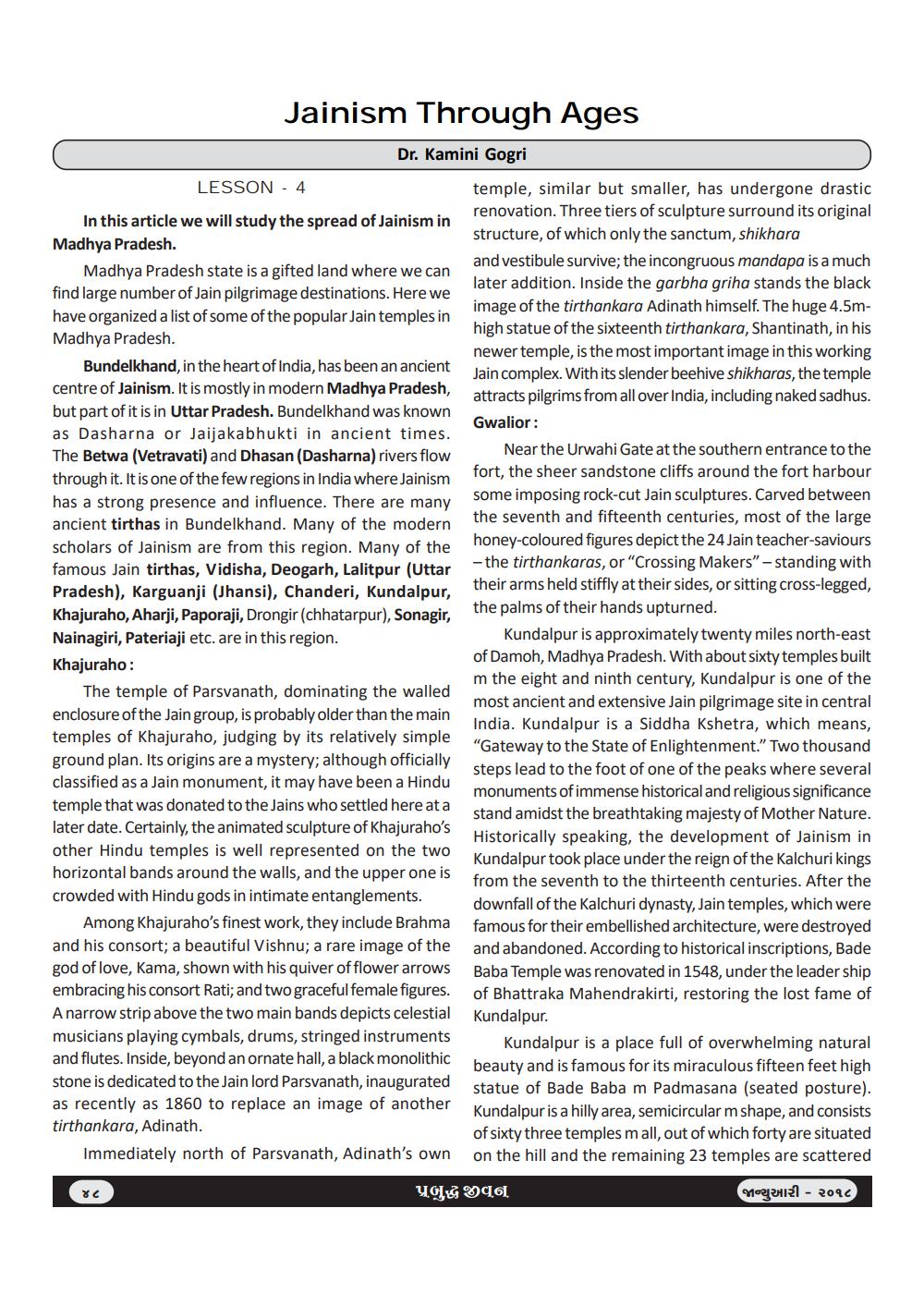________________
Jainism Through Ages
Dr. Kamini Gogri
LESSON - 4
In this article we will study the spread of Jainism in Madhya Pradesh.
Madhya Pradesh state is a gifted land where we can find large number of Jain pilgrimage destinations. Here we have organized a list of some of the popular Jain temples in
Madhya Pradesh.
Bundelkhand, in the heart of India, has been an ancient centre of Jainism. It is mostly in modern Madhya Pradesh,
but part of it is in Uttar Pradesh. Bundelkhand was known as Dasharna or Jaijakabhukti in ancient times. The Betwa (Vetravati) and Dhasan (Dasharna) rivers flow through it. It is one of the few regions in India where Jainism has a strong presence and influence. There are many ancient tirthas in Bundelkhand. Many of the modern scholars of Jainism are from this region. Many of the famous Jain tirthas, Vidisha, Deogarh, Lalitpur (Uttar Pradesh), Karguanji (Jhansi), Chanderi, Kundalpur, Khajuraho, Aharji, Paporaji, Drongir (chhatarpur), Sonagir, Nainagiri, Pateriaji etc. are in this region. Khajuraho:
The temple of Parsvanath, dominating the walled enclosure of the Jain group, is probably older than the main temples of Khajuraho, judging by its relatively simple ground plan. Its origins are a mystery; although officially classified as a Jain monument, it may have been a Hindu temple that was donated to the Jains who settled here at a later date. Certainly, the animated sculpture of Khajuraho's other Hindu temples is well represented on the two horizontal bands around the walls, and the upper one is crowded with Hindu gods in intimate entanglements.
Among Khajuraho's finest work, they include Brahma and his consort; a beautiful Vishnu; a rare image of the god of love, Kama, shown with his quiver of flower arrows embracing his consort Rati; and two graceful female figures. A narrow strip above the two main bands depicts celestial musicians playing cymbals, drums, stringed instruments and flutes. Inside, beyond an ornate hall, a black monolithic stone is dedicated to the Jain lord Parsvanath, inaugurated as recently as 1860 to replace an image of another
tirthankara, Adinath.
૪૮
temple, similar but smaller, has undergone drastic renovation. Three tiers of sculpture surround its original structure, of which only the sanctum, shikhara
and vestibule survive; the incongruous mandapa is a much later addition. Inside the garbha griha stands the black image of the tirthankara Adinath himself. The huge 4.5mhigh statue of the sixteenth tirthankara, Shantinath, in his newer temple, is the most important image in this working Jain complex. With its slender beehive shikharas, the temple attracts pilgrims from all over India, including naked sadhus.
Gwalior :
Near the Urwahi Gate at the southern entrance to the
fort, the sheer sandstone cliffs around the fort harbour some imposing rock-cut Jain sculptures. Carved between the seventh and fifteenth centuries, most of the large honey-coloured figures depict the 24 Jain teacher-saviours -the tirthankaras, or "Crossing Makers" - standing with their arms held stiffly at their sides, or sitting cross-legged, the palms of their hands upturned.
Kundalpur is approximately twenty miles north-east of Damoh, Madhya Pradesh. With about sixty temples built m the eight and ninth century, Kundalpur is one of the most ancient and extensive Jain pilgrimage site in central India. Kundalpur is a Siddha Kshetra, which means, "Gateway to the State of Enlightenment." Two thousand steps lead to the foot of one of the peaks where several monuments of immense historical and religious significance stand amidst the breathtaking majesty of Mother Nature. Historically speaking, the development of Jainism in Kundalpur took place under the reign of the Kalchuri kings from the seventh to the thirteenth centuries. After the downfall of the Kalchuri dynasty, Jain temples, which were famous for their embellished architecture, were destroyed and abandoned. According to historical inscriptions, Bade Baba Temple was renovated in 1548, under the leadership of Bhattraka Mahendrakirti, restoring the lost fame of Kundalpur.
Kundalpur is a place full of overwhelming natural beauty and is famous for its miraculous fifteen feet high statue of Bade Baba m Padmasana (seated posture). Kundalpur is a hilly area, semicircular m shape, and consists of sixty three temples m all, out of which forty are situated
Immediately north of Parsvanath, Adinath's own on the hill and the remaining 23 temples are scattered
પ્રબુદ્ધજીવન
જાન્યુઆરી - ૨૦૧૮




